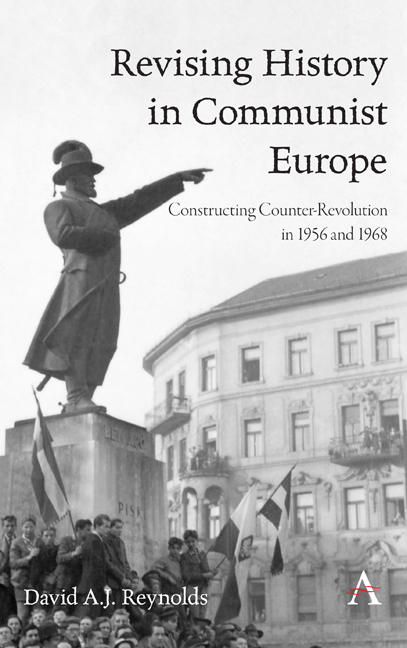Book contents
- Frontmatter
- Dedication
- Epigraph
- Contents
- Acknowledgements
- Introduction
- 1 The Export and Imposition of Stalinism
- 2 Hungarian De-Stalinization and Revising Recent History
- 3 A Revolution, a Counter-Revolution, or a National Uprising?
- 4 Stalinist Purges and De-Stalinization in Czechoslovakia
- 5 The Meaning of 1956 in 1968: March to June
- 6 June: Turning Point and the Hardening of Positions
- 7 July and August: Constructing Counter-Revolution
- 8 The Intentions of Intervention and the Shadow of 1956: Delusion and Failure
- Conclusion
- Epilogue
- Appendix
- Bibliography
- Index
- Frontmatter
- Dedication
- Epigraph
- Contents
- Acknowledgements
- Introduction
- 1 The Export and Imposition of Stalinism
- 2 Hungarian De-Stalinization and Revising Recent History
- 3 A Revolution, a Counter-Revolution, or a National Uprising?
- 4 Stalinist Purges and De-Stalinization in Czechoslovakia
- 5 The Meaning of 1956 in 1968: March to June
- 6 June: Turning Point and the Hardening of Positions
- 7 July and August: Constructing Counter-Revolution
- 8 The Intentions of Intervention and the Shadow of 1956: Delusion and Failure
- Conclusion
- Epilogue
- Appendix
- Bibliography
- Index
Summary
Twenty years after the Prague Spring and 32 years after the Hungarian uprising, János Kádár was gently but unmistakably ushered from his place at the head of the MSZMP. In the same spring of 1988, a new organization of former political prisoners had been formed: the Committee for Historical Justice (Történelmi Igazságtétel Bizottság). It commemorated the 30th anniversary of the Nagy trial, demanding ‘the rehabilitation of those executed, their suitable internment, a re-evaluation of recent history and the release of sources and materials that would make possible untainted historical research’. A few weeks after that anniversary, Kádár's successor, Károly Grósz, on a visit to the United States, promised a Hungarian group that the reburial of Imre Nagy, whose body still rested uneasily in unmarked oblivion, would be permitted. In November, as the Central Committee voted through sweeping liberalizations, the Politburo endorsed Grósz's unofficial commitment to reburials. Then in January 1989, the reformist Politburo member, Imre Pozsgay, who had been placed in charge of a commission to delve into the recent past, described Hungary's 1956 as a ‘popular uprising’. This declaration, as Rainer describes, was ‘explosive and had a much more intense effect than the party leadership […] had foreseen’. A month later, the regime officially endorsed this momentous reformulation.
Bodies that had been purposefully buried with flippant disrespect had to be located and exhumed. Nagy and his fellow executed leaders, it turned out, had been committed to the ground face down, their remains interspersed with the bones of animals from the Budapest zoo. Meanwhile, the government, which the party had (characteristically in 1989) deferred to in the oversight of the reburial, intended a private and quiet reinternment, just as the party had hoped for László Rajk in the 1950s. But, also reminiscent of October 1956, this vain hope was abandoned. Instead, the Committee for Historical Justice planned a deeply symbolic ceremony in Hősök tere on the 31st anniversary of Nagy's execution and hired an architect to design the stage and backdrop – László Rajk, son of the man whose dramatic reburial presaged the uprising for which Nagy had been executed.
- Type
- Chapter
- Information
- Revising History in Communist EuropeConstructing Counter-Revolution in 1956 and 1968, pp. 209 - 210Publisher: Anthem PressPrint publication year: 2020



